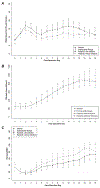Hematologic changes after splenectomy for ovarian cancer debulking surgery, and association with infection and venous thromboembolism
- PMID: 32665236
- PMCID: PMC8369877
- DOI: 10.1136/ijgc-2020-001368
Hematologic changes after splenectomy for ovarian cancer debulking surgery, and association with infection and venous thromboembolism
Abstract
Introduction: The spleen plays a role in the immune and coagulative responses, yet a splenectomy may be required during ovarian cancer surgery to achieve complete cytoreduction. The aim of the study was to correlate hematologic changes with the development of infection and venous thromboembolism in patients undergoing splenectomy.
Methods: This single-institution retrospective review includes all patients undergoing splenectomy during cytoreductive surgery for advanced ovarian cancer, March 2001 to December 2016. We compared postoperative hematologic changes (evaluated daily before discharge) in patients developing infection within 30 days' post-surgery (Infection group) with those who did not (No-Infection group). We also compared patients developing venous thromboembolism with those without.
Results: A total of 265 patients underwent splenectomy. Median age was 64 years (range 22-88): 146 (55%) patients had stage IIIC and 114 (43%) patients had stage IV. The majority, 201 (76%) patients underwent splenectomy during primary debulking. A total of 132 (50%) patients comprised the Infection group (most common: urinary tract infection, 54%). Median time from surgery to infection was 8 days (range, 0-29). After initial rise in white blood cell count in both groups, the Infection group had a second peak on postoperative day 10 (median 16.6K/mcL, IQR 12.5-21.2) not seen in the No-Infection group (median 12K/mcL, IQR 9.3-16.3). A total of 40 (15%) patients developed venous thromboembolism, median time of 6.5 days (range, 1-43). All patients demonstrated a continuous rise in platelets during postoperative days 0-15. Thrombocytosis was present in 38/40 (95%) patients with venous thromboembolism vs 183/225 (81%) patients without (P=0.036). Median days with thrombocytosis was higher in venous thromboembolism (8 days, range 1-15) vs non groups (6 days, range 1-16, P=0.049).
Conclusion: We identified initial leukocytosis after splenectomy in all patients. The Infection group had a second peak in white blood cell count on postoperative day 10, not present in the No-Infection group. Among patients with venous thromboembolism, thrombocytosis was more frequent and of longer duration.
Keywords: ovarian cancer; surgery; surgical procedures, operative.
© IGCS and ESGO 2020. No commercial re-use. See rights and permissions. Published by BMJ.
Conflict of interest statement
Competing interests: None declared.
Figures


References
-
- Horowitz J, Leonard D, Smith J, Brotman S. Postsplenectomy leukocytosis: physiologic or an indicator of infection? Am Surgeon 1992;58:387–90. - PubMed
Publication types
MeSH terms
Grants and funding
LinkOut - more resources
Full Text Sources
Medical

